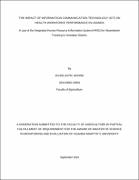| dc.description.abstract | The overall objective of this study was to establish the effectiveness of using HRIS to optimize performance, quality and impact of the health workforce using a case study of absenteeism tracking in Amolatar district of Northern Uganda. Specifically, the study determined the role of HRIS in enhancing capacity for human resources for health policy and planning, its impact on health service delivery outcomes and attendance of health workers. a cross-sectional descriptive survey design, which included use of both qualitative and quantitative research approaches was used. Data on perceptions and practices were collected using questionnaires, Key Informant Interviews and Focused Group Discussions with the District Health Management Team, the Human Resource Office (Administrative) and Health workers.
Results showed 100% existence of tools and practices to track health workers attendance including the use of attendance registers, duty rosters, leave forms and the use of both electronic and manual systems for analysis of attendance records. Analysis of absenteeism was 47% Manual and 53% computer/electronic based. It also showed that attendance reports were generated and shared with the DHO (88.9%) and the HUMCs. However, these had not been shared with the PHRO for actions such as warning letters, reduced pay or other sanctions in place by the Ministry of Public Service.
There was consistency in health seeking behavior which was analyzed from the health indicators of Immunization, Ante-natal and Post-natal services, facility delivery, family planning usage and other infectious diseases. An average of 368 of the 6,949 Children (Based on 2017 Population estimates) had completed immunization in the 1-year period (Sept 16- Sept 17) as indicated by Measles immunization trends. This shows only 5% children in Amolatar were able to complete their immunization schedules.
The introduction and use HRIS has improved health workers attendance in all the health facilities with 57% facilities reporting very low absenteeism rates in their last reports which was mainly attributed to support staff including askaris and nursing assistants who lacked accommodation at the health facilities and a few that have absented from work due to salary issues. | en_US |


